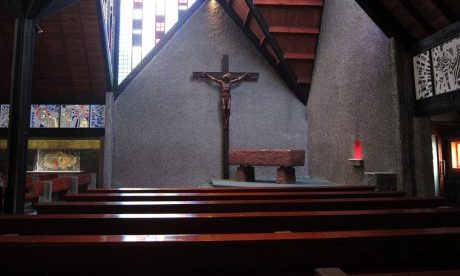Amid the well-groomed homes and quiet roads in the suburbs of Karori in Wellington rises an unexpected structure, with a steep, folded roof that pierces the sky.
Designed by John Scott, a New Zealand architect of Irish, Scottish, and Māori descent, the Futuna Chapel has stood on its plot for nearly 60 years, regarded as “the most complete example of a modern ‘indigenous’ New Zealand design.”
While originally created as a chapel in a retreat center for the Catholic Marist Brothers, it also integrates elements adopted from Māori communal spaces, making it a building that bridges cultures. Towering above the rows of standard pews and friezes showing the Stations of the Cross is a large post that branches to the ceiling — it recalls a poutokomanawa, a carved wooden central support of a traditional Māori meeting house, or wharenui.
Today, the Futuna Chapel is nondenominational, hosting occasional concerts and lectures by speakers including architects Alejandro Aravena and Niall McLaughlin. (In April, as part of its annual lecture series, the chapel will welcome a professor of new media art and cultural heritage.)
On sunny Wellington days, rays stream through the colorful acrylic window panels designed by Auckland sculptor Jim Allen and fixed into the soaring ceiling. They transform the space into a shimmering jewel box with varying textures.
The light casts gridded, rainbow patterns on the roughcast plaster walls and the floor made of pounamu, a beautiful serpentine marble that holds special value for Māori.
Although small, Futuna keeps your eyes wandering, like a sculpture that reveals its secrets as you slowly observe it in the round. Scott built it on a square plan, but its regular base is offset by the angular ceiling, which features striking rafters.
As you move through the chapel, hidden niches fitted with more windows emerge above you, including one that allows sun to spotlight the altar, made of South African red granite. Its roughness contrasts sharply with the smooth side altars made of white Kairuru marble, above which protrude detailed mosaics showing Mary, Chanel, Jesus, and St. Joseph with the baby Jesus. Continue reading
Source and Image
- Hyperallergic article by Claire Voon, a staff writer at Hyperallergic.
News category: Features.




